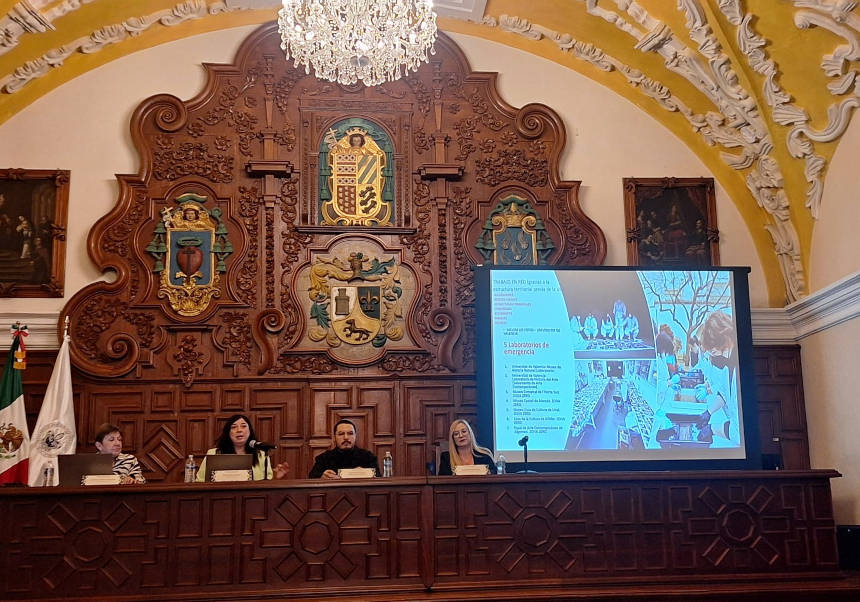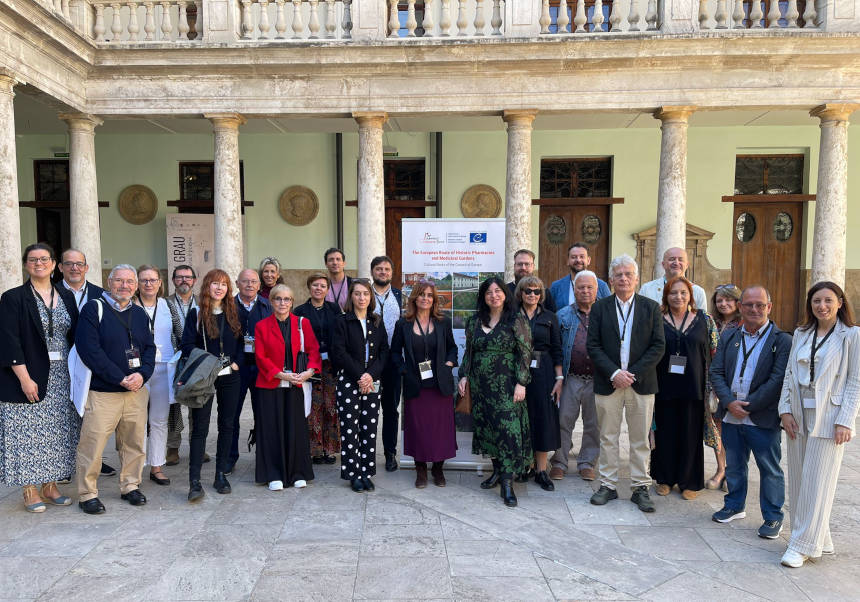The Universitat de València presents unpublished work by Manuela Ballester
- University Culture Service
- May 22nd, 2024

The UV has organised the largest retrospective of the Valencian artist Manuela Ballester (1908 - 1994) at La Nau Cultural Centre. Happening at the same time as International Women's Day and the 30th anniversary of her death, the UV showcased the exhibition on the Valencian artist from the generation of the 30s. There is more to the exhibition. It allowed the UV to trace one of her works, which was thought to be lost: Memory of Valencia (orig. Recuerdo de Valencia).
More than 380 works and documents illustrate the prolific career of an artist with her own identity, who deserves recognition beyond being the wife of the artist Josep Renau.
The painting Memory of Valencia was inaugurated this morning in the Academy Hall, one of the exhibition rooms, in a ceremony presided by Principal Maria Vicenta Mestre, and attended by Vice-Principal for Culture and Society Ester Alba and curator of the exhibition Carmen Gaitán Salinas.
The principal thanked the owner of the painting, Manuel Sánchez, for his generosity and the team from the Office of the Vice-Principal for Culture and Society for making this great retrospective possible, ‘which defends not only the important figure of Manuela Ballester, but also the figure of every artist and an entire generation condemned by exile.’ Maria Vicenta Mestre also paid tribute to the 50 private lenders who made it possible for the UV to host this magnificent exhibition in the same year that the institution celebrates its 525th anniversary.
Vice-Principal Ester Alba explained the extensive programme of complementary activities and emphasised the institutional interest in the exhibition's international itinerary.
Manuel Sánchez explained that he came into possession of the painting thanks to his grandparents, who were also artists. Sánchez added that there was a sense of brotherhood among the exiles.
How did this work end up at the Universitat de València?
According to the curator, after the opening, ‘many people contacted us to get to know Manuela Ballester.’ In fact, the uniqueness of the exhibition lies in the fact that it has become ‘the meeting point’ for works from more than 50 private lenders who have kept works by an artist with an extensive production, both in Spain and abroad. Among these contributions, the surprise came a month ago, through the Museo Nacional Centro de Arte Reina Sofía, which allowed to locate a painting that was thought to be lost and that is very important to the artistic production of Manuela Ballester, both for its significance and for its context and presentation. The work is Memory of Valencia, painted in 1939, and located in Madrid, although it was always thought to be in Mexico, where the author had gone into exile.
In this painting there is a bust of a woman in a vase, whose neck is decorated with marine elements. It is a somewhat atypical image, with a Dadaist inspiration. The bust of the woman in the vase rests on a red cloth and looks at a green and white curtain. These three colours, together with the waving of the curtain, represent the Mexican flag. As the curator explains, the image has a scenographic look, which is very common in Ballester’s other works. The woman is looking at the waving curtain, with the sea and a boat on the beach behind her. These elements recur in several of her works and are reminiscent of the Valencia of Ballester’s past.
According to Carmen Gaitán Salinas, Memory of Valencia recalls a version of Valencia that the artist would read about years later in Azorín’s work. She noted her impressions in her diaries and made references to this Valencia as the one she carried with her in her blood. In her diaries, Manuela expresses that she yearns to be Valencian, to be Spanish, while describing her longing for a lost homeland, which will continue to form part of her artistic journey.
The painting, oil on wood, was exhibited in Painting in exile (orig. Pintura en el destierro), organised by the Casa de la Cultura Española in Mexico in March, 1940. This exhibition marked the inauguration of the centre, created as the headquarters of the Junta de Cultura Española. It was originally financed in Paris with the collaboration of Picasso and chaired by José Bergamín. The aim was to prevent the disintegration of Spanish intellectuals as a result of the war and exile. Announced as a collection of modern Spanish painting, the exhibition was so successful that it was featured in exile magazines like Romance. Revista Popular Hispanoamericana.
At first, the painting was thought to be lost, as the curator’s investigation in 1974 showed that Ballester had made a very similar version of Memory of Valencia and had given it the same title. The fact that she made a second version, so much later, led us to believe that the second version was made to commemorate the lost first, which the UV was able to find.
The importance of Memory of Valencia lies in the fact that it is one of the first works that Ballester painted during the Republican exile, and probably also one of the first to be created in her new home, Mexico. This painting places Ballester as a fundamental part of the cultural fabric of Spain, a country that fought relentlessly for democratic values.
The exhibition Manuela Ballester. Painting towards everything (orig. Manuela Ballester. Pintar frente a todo) is the result of a decade of thorough research, and it is curated by Carmen Gaitán Salinas, senior researcher at the CSIC’s Department of Art History and Cultural Heritage. It hopes to enhance the understanding of the scope and significance of the painter’s artistic activity. It sheds light on unpublished works and is the first major retrospective of the artist. The exhibition brings together numerous works that present a wide variety of formats, languages and techniques from her extensive artistic production both in Spain and abroad. From Valencia to exile in East Germany and Mexico, she experienced a life marked by paintbrushes, murals and personal struggle. The exhibition comprises portraits, magazine illustrations, editorial covers, fashion illustrations, posters, murals and advertising projects. These works are presented alongside photographs, publications and archival documents to create a better understanding of her multifaceted career.
During the event, the catalogue and the international conference on 20 June at the IVAM with a guided tour of the exhibition were also presented.
Categories: Patrimoni Cultural
















